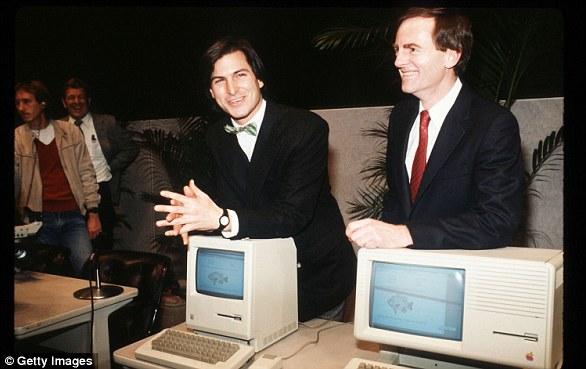Apple has removed its highest level data security tool in the UK, known as Advanced Data Protection (ADP).
ADP protects data stored in iCloud with end-to-end encryption, which means the data can only be seen by the user who owns it, and only on their trusted devices.
The decision to remove the tool comes shortly after the UK government asked for the right to see data.
‘Apple can no longer offer Advanced Data Protection (ADP) in the United Kingdom to new users and current UK users will eventually need to disable this security feature,’ an Apple spokesperson said.
‘We are gravely disappointed that the protections provided by ADP will not be available to our customers in the UK given the continuing rise of data breaches and other threats to customer privacy.’
If you use an iPhone, here’s what the change means for you and your private data.

Apple has removed its highest level data security tool in the UK, known as Advanced Data Protection (ADP)
What is Advanced Data Protection?
Advanced Data Protection (ADP) is Apple’s highest level of cloud data security, and is designed to protect your data using end-to-end encryption.
Until now, this has meant that no one else can access your data – not even Apple, and this data remains secure even in the case of a data breach in the cloud.
However, Apple has now removed ADP as a feature to new users in the UK, in response to a request earlier this month from the UK government.
‘Enhancing the security of cloud storage with end-to-end encryption is more urgent than ever before,’ the Apple spokesperson said.
‘Apple remains committed to offering our users the highest level of security for their personal data and are hopeful that we will be able to do so in the future in the United Kingdom.
‘As we have said many times before, we have never built a backdoor or master key to any of our products or services and we never will.’
What does this mean for iPhone users?
Thankfully, the removal will not affect the 14 iCloud data categories that are end-to-end encrypted by default.

ADP protects data stored in iCloud with end-to-end encryption, which means the data can only be seen by the users who owns it, and only on their trusted devices
This includes data like iCloud Keychain and Health, as well as communication services like iMessage and FaceTime.
‘Apple doesn’t have the encryption keys for these categories, and we can’t help you recover this data if you lose access to your account,’ Apple explains on its website.
However, nine iCloud categories will now only be protected by Standard Data Protection, with no option for end-to-end encryption.
These nine categories are iCloud Backup, iCloud Drive, Photos, Notes, Reminders, Safari Bookmarks, Siri Shortcuts, Voice Memos, Wallet Passes, and Freeform.
‘Standard data protection is the default setting for your account,’ Apple explains on its website.
‘Your iCloud data is encrypted in transit and stored in an encrypted format at rest.
‘The encryption keys from your trusted devices are secured in Apple data centres, so Apple can decrypt your data on your behalf whenever you need it, such as when you sign in on a new device, restore from a backup or recover your data after you’ve forgotten your password.
‘As long as you can sign in to your Apple Account successfully, you can access your backups, photos, documents, notes and more.’
From today, Apple can no longer offer ADP to new users.
And if you’re in the UK and already have it enabled, Apple says it will soon provide guidance on what to do.
The tech giant is unable to disable ADP automatically, and instead, you’ll be given a period of time to disable it yourself in order to keep using your iCloud account.
Outside of the UK, ADP continues to be available everywhere.
Why has Apple removed ADP in the UK?
Earlier this month, the UK government demanded to be able to access encrypted data stored by Apple users in its cloud service.
The demand was served by the Home Office under the Investigatory Powers Act (IPA), which compels firms to provide information to law enforcement agencies.
At the time, Apple declined to comment, but pointed out on its website that it views privacy as a ‘fundamental human right’.

‘We are gravely disappointed that the protections provided by ADP will not be available to our customers in the UK given the continuing rise of data breaches and other threats to customer privacy,’ an Apple spokesperson said. Pictured: Apple CEO, Tim Cook
What has the response been?
So far, the news has received mixed reviews.
Rani Govender, Policy Manager for Child Safety Online at the NSPCC, said: ‘We know that end-to-end encryption allows offenders to groom and manipulate children and build communities where they can share vile child sexual abuse material without detection.
‘As Apple change their approach to encryption on their services, they must take this opportunity to ensure that they are considering other measures they can put in place to better protect children.
‘All tech companies should be finding ways to tackle online risks to children whilst upholding privacy of their users, and Ofcom and Government should hold them accountable for doing so.’
However, Jake Moore, Global Cybersecurity Advisor at ESET, said that the change raises ‘enormous concerns regarding user privacy and data security.’
‘Apple’s decision raises enormous concerns regarding user privacy and data security whilst marking a huge step backwards in the protection of privacy online,’ he warned.
‘Creating a backdoor for ethical reasons means it will inevitably only be a matter of time before threat actors also find a way in.
‘iCloud storage contains highly personal and sensitive data and remains backed up for protection and safety.
‘To know this data could now be accessed breaks the trust between users and technology companies, effectively ripping a hole in the internet.
‘This development not only impacts UK users but it also sets a concerning precedent for global privacy rights as it may encourage other governments to look at similar actions, potentially undermining the fundamental principles of end-to-end encryption and user trust in digital services.’

















